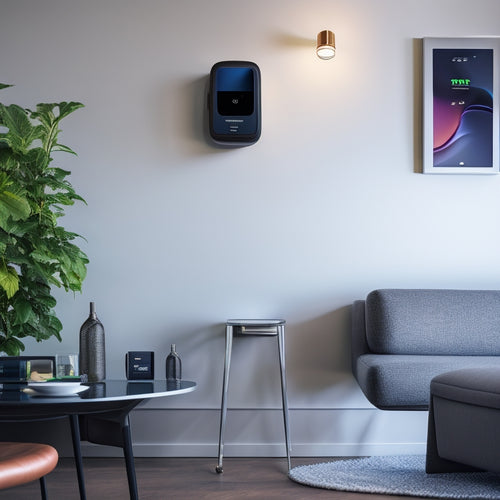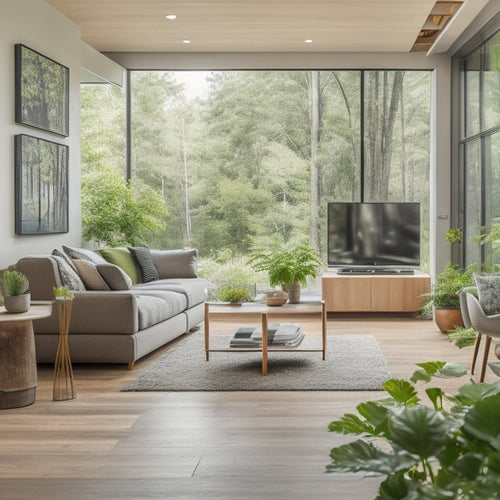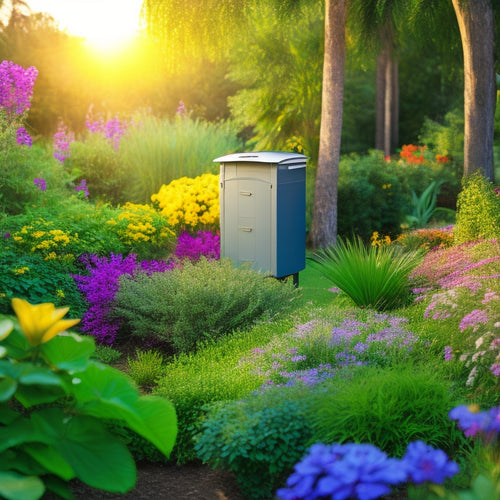
Green Humidifiers Vs Dehumidifiers: Top 10 Picks
Share
When it comes to creating a healthier and more sustainable living space, you're likely considering both green humidifiers and dehumidifiers. Energy-efficient options with smart technology and eco-friendly materials are a necessity. Look for humidifiers with low water usage, natural purification, and modern designs that fit seamlessly into your home. Dehumidifiers with Energy Star ratings, low toxic emissions, and renewable energy solutions are also essential. To make an informed decision, you'll want to investigate the top 10 picks that balance performance, energy efficiency, and environmental responsibility - and delve into the details that will help you find the perfect fit for your space.
Key Takeaways
- Green humidifiers prioritize energy efficiency, using renewable energy sources and sustainable materials to reduce carbon footprint and environmental guilt.
- Eco-friendly dehumidifiers feature low toxic emissions, Energy Star ratings, and integration of renewable energy sources to minimize environmental impact.
- High-capacity humidifiers provide long-lasting relief from dry air, ideal for large rooms or homes with multiple occupants, while low water technology minimizes waste.
- Dehumidifier models with Energy Star ratings, automatic shut-off, and low-power modes optimize energy use and reduce high energy bills.
- Regular maintenance, filter cleaning, and humidity level monitoring ensure efficient operation and ideal indoor air quality for both humidifiers and dehumidifiers.
Energy-Efficient Humidifier Options
When dry air starts to take its toll on your skin and sinuses, a humidifier can be a lifesaver.
Energy-efficient humidifier options are a must-have for those who value freedom from high energy bills and environmental guilt. Look for smart humidifier technology that adjusts moisture levels based on humidity and temperature.
Additionally, incorporating renewable energy solutions like solar panels or wind energy can further reduce your carbon footprint. Sustainable material choices, such as BPA-free plastic or recyclable components, are also crucial.
Opt for a humidifier with an Energy Star certification, which guarantees it meets energy efficiency standards set by the U.S. EPA.
Dehumidifier Models for Small Spaces
How do you prevent moisture buildup in your small space without sacrificing precious floor real estate? You need a dehumidifier that's designed for compact spaces. Look for models with a compact design that won't overwhelm your room. Consider noise levels, air quality, and moisture control when choosing the right dehumidifier for your space.
| Model | Room Size | Budget Options |
|---|---|---|
| Frigidaire FFAD3033R1 | Up to 300 sq. ft. | Under $200 |
| Keystone KSTAD50B | Up to 3000 sq. ft. | Under $300 |
| Eva-Dry EDV-1100 | Up to 1100 sq. ft. | Under $150 |
When selecting a dehumidifier, prioritize portability features, smart technology, and safety features. Read user reviews to verify you're getting a model that meets your needs. By considering these factors, you'll find a dehumidifier that fits your small space and budget.
Humidifiers With Low Water Usage
You've optimized your small space for dry air, but what about when the seasons shift and dryness becomes a problem? That's where humidifiers with low water usage come in.
These devices are designed to provide the right amount of moisture without wasting resources. Compact humidifier designs make them perfect for small spaces, while low water technology guarantees you're not guzzling water.
By choosing a humidifier with low water usage, you're taking a step towards a more sustainable living space, much like fleets adapting to renewable energy conversion kits to reduce their carbon footprint. This alteration in technology helps reduce greenhouse gas emissions and contributes to climate leadership.
Look for humidifiers with features like automatic shut-off, water level indicators, and adjustable mist output to minimize water consumption. With these features, you can maintain a comfortable humidity level without breaking the bank or harming the environment.
Eco-Friendly Dehumidifier Features
When you're shopping for an eco-friendly dehumidifier, you'll want to look for models that meet energy efficiency standards, such as the Energy Star rating, which guarantees the device uses less power without sacrificing performance.
You'll also want to check for low toxic emissions, as some dehumidifiers can release harmful chemicals into the air.
Additionally, considering the integration of renewable energy sources, such as solar roofing systems, can further reduce the carbon footprint of your dehumidifier.
By utilizing solar power, you can decrease your reliance on fossil fuels and lower operating costs.
Energy Efficiency Standards
Your eco-friendly dehumidifier's energy efficiency standards are essential in reducing its environmental impact. By choosing a dehumidifier with high energy efficiency, you'll not only reduce your energy consumption but also lower your utility bills. Look for dehumidifiers with the ENERGY STAR certification, which indicates that they meet strict energy efficiency guidelines set by the U.S. Environmental Protection Agency.
| Feature | Description |
|---|---|
| Energy Star Certification | Indicates compliance with energy efficiency guidelines |
| Energy Consumption (W) | Measures the dehumidifier's power usage |
| Moisture Removal (Pints/Day) | Indicates the dehumidifier's capacity to remove moisture |
| Water Tank Capacity (Pints) | Determines how often you need to empty the tank |
| Auto-Shutoff | Automatically turns off the dehumidifier when the tank is full |
When shopping for an eco-friendly dehumidifier, prioritize energy efficiency to support sustainability practices and reduce your carbon footprint.
Low Toxic Emissions
In addition to energy efficiency, an eco-friendly dehumidifier should also prioritize low toxic emissions to minimize its environmental impact.
You want a dehumidifier that employs low emission technologies to reduce its carbon footprint. Look for models with eco-friendly refrigerants, such as R-410A or R-32, which have minimal ozone depletion potential and low global warming potential.
These refrigerants guarantee that your dehumidifier doesn't harm the environment while keeping your indoor air quality clean.
High-Capacity Humidifier Picks
Several high-capacity humidifier models stand out for their exceptional performance, making them ideal for large spaces or areas with particularly dry air. When shopping for a high-capacity humidifier, you'll want to take into account features like humidifier capacity, runtime, and mist output.
| Model | Humidifier Capacity | Runtime |
|---|---|---|
| Honeywell HUL520W | 1 gallon | 24 hours |
| Levoit LV600HH | 1.5 gallons | 36 hours |
| Dyson AM10 | 3 gallons | 18 hours |
| Vicks Warm Mist | 1 gallon | 24 hours |
| Crane Drop Ultrasonic | 1 gallon | 24 hours |
These high-capacity humidifiers are designed to provide long-lasting relief from dry air, making them perfect for large rooms or homes with multiple occupants. Look for models with high capacity features, such as large water tanks and powerful mist output, to guarantee you get the relief you need.
Dehumidifier Energy Star Ratings
Its energy efficiency is an essential aspect to take into account when shopping for a dehumidifier. You want to make certain that the device you choose won't skyrocket your energy bills.
Look for a dehumidifier with an Energy Star rating, which indicates that it meets energy efficiency standards set by the U.S. Environmental Protection Agency. Many commercial operations are adopting fast charging infrastructure to reduce their carbon footprint, and similarly, choosing an energy-efficient dehumidifier can contribute to a more sustainable future.
Thanks to dehumidifier technology advancements, many modern models come with energy saving features that reduce power consumption without compromising performance. These features may include automatic shut-off, low-power modes, and smart sensors that optimize energy use.
When browsing through dehumidifier options, check the Energy Star certification and the manufacturer's claims about energy efficiency to make an informed decision.
Humidifiers With Natural Purification
You've considered the energy efficiency of dehumidifiers, now let's investigate the benefits of humidifiers with natural purification.
These devices don't just add moisture to the air, they also cleanse it using natural ingredients. By incorporating elements like activated carbon, essential oils, or plant-based filters, humidifiers with natural purification can remove impurities and allergens from the air.
Additionally, integrating solar energy solar-powered solutions can enhance the eco-friendliness of these devices, reducing their carbon footprint and reliance on non-renewable sources. This results in improved air quality, which is essential for people with respiratory issues or sensitivities.
Look for humidifiers that use natural ingredients for air purification, as they provide a healthier alternative to chemical-based purifiers. With natural purification, you can breathe easier, knowing your air is clean and fresh.
Dehumidifier Maintenance Essentials
You'll want to establish a regular filter cleaning schedule to guarantee your dehumidifier operates efficiently and effectively.
Additionally, it's essential to monitor the humidity level in your space to adjust the dehumidifier's settings accordingly, as this will impact its performance and energy consumption.
Filter Cleaning Schedule
When your dehumidifier is working efficiently, it's easy to overlook the importance of regular filter cleaning.
However, a dirty filter can greatly reduce your dehumidifier's performance and increase energy consumption. To avoid this, you should establish a filter cleaning schedule.
Here are some filter maintenance tips to keep in mind:
- Check your filter every 1-2 weeks, depending on usage and environmental conditions
- Gently vacuum or wash the filter with warm soapy water to remove dirt and debris
- Dry the filter thoroughly before reinstalling it to prevent moisture buildup
- Replace the filter every 1-3 months or according to the manufacturer's recommended filter replacement frequency
Humidity Level Monitoring
Monitoring humidity levels is essential to confirm your dehumidifier operates efficiently and effectively. You want to verify your indoor air quality is ideal, and humidity control techniques play a significant role in achieving this. Regular monitoring helps you identify when your dehumidifier needs maintenance or replacement.
| Humidity Level | Air Quality | Dehumidifier Action |
|---|---|---|
| 30-50% | Good | Operates normally |
| 50-60% | Fair | Increases fan speed |
| 60-80% | Poor | Activates alarm or alert |
| 80-90% | Bad | Shuts off to prevent damage |
| Above 90% | Hazardous | Requires immediate attention |
Humidifier Design for Modern Homes
Modern homes often feature sleek, minimalist designs, and humidifiers are no exception. You want a humidifier that not only does its job but also complements your home's aesthetic. Look for humidifiers with minimalist humidifier aesthetics that blend seamlessly into your modern space.
Some key design features to evaluate include:
- Compact sizes that fit snugly on shelves or nightstands
- Sleek, modern materials like glass or stainless steel
- Smart humidifier technology that lets you control the device remotely
- Whisper-quiet operation that won't disrupt your daily routine
Top Dehumidifier Brands Compared
Clarity is key when it comes to controlling humidity levels in your home, and choosing the right dehumidifier brand can make all the difference. You want a brand that's reliable, efficient, and meets your specific needs.
To help you make an informed decision, we've compared top dehumidifier brands, considering factors like performance, energy consumption, and customer reviews. In our top dehumidifier reviews, you'll find brands like Frigidaire, Honeywell, and LG, which offer a range of features and price points.
When creating your dehumidifier buying guide, consider the moisture removal capacity, noise level, and additional features like built-in humidistats and smart sensors. By evaluating these factors, you'll find the perfect dehumidifier for your home and enjoy a healthier, more comfortable living space.
Frequently Asked Questions
Can I Use a Humidifier and Dehumidifier in the Same Room?
As you walk the tightrope of humidity balance, you wonder, "Can I use a humidifier and dehumidifier in the same room?" Yes, you can, as long as you're mindful of air quality and adjust settings to harmonize your space's moisture levels.
Do Humidifiers and Dehumidifiers Require Regular Filter Replacements?
You'll need to perform regular filter maintenance on both humidifiers and dehumidifiers, as they require different filter types, such as HEPA or carbon filters, which need replacement every 1-3 months to guarantee peak performance and air quality.
Are Humidifiers and Dehumidifiers Safe for Pets and Children?
You'll want to guarantee pet safety and child health by choosing humidifiers and dehumidifiers with safety features like automatic shut-off, secure water tanks, and non-toxic materials, allowing you to breathe easy while maintaining a healthy environment for your loved ones.
Can I Clean and Reuse Humidifier and Dehumidifier Filters?
As you breathe in the fresh air, remember that filter maintenance is key; you can clean and reuse humidifier and dehumidifier filters by following proper cleaning methods, like gentle washing and drying, to guarantee their effectiveness and your freedom from respiratory issues.
Do Humidifiers and Dehumidifiers Come With a Warranty or Guarantee?
You'll be relieved to know that most humidifiers and dehumidifiers come with a warranty or guarantee, typically ranging from one to five years, which speaks to the product's reliability and gives you peace of mind about the warranty duration.
Related Posts
-

7 Best EV Battery Health Trackers for Homeowners
You can maximize your electric vehicle's performance and lifespan by leveraging advanced battery health trackers that...
-

Why EVs Inspire Earth-Conscious Home Design Choices
As you shift to an electric vehicle, you're not just switching to a greener ride, you're igniting a broader commitmen...
-

Why Choose Solar Composting Toilets for Your Home?
By choosing a solar composting toilet for your home, you'll greatly reduce your environmental impact, slashing your w...


